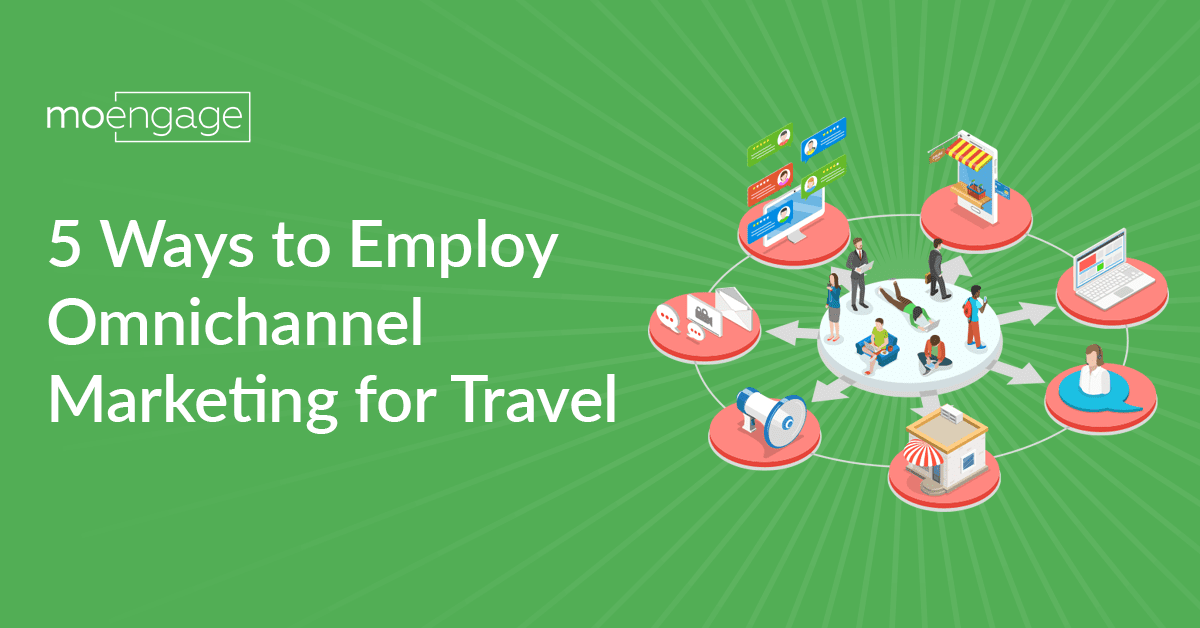5 Ways to Employ Omnichannel Marketing for Travel Industry

Reading Time: 4 minutes
Omnichannel marketing is usually associated with the e-commerce industry. But do you know you can also use it for your travel business?
82% of the travel bookings happen through a website or a mobile app. 90% of travelers seek personalized travel recommendations while planning their trip.
However, it’s a perfect opportunity for you to use omnichannel marketing to grow your online travel business.
In this article, we will tell you five ways in which you can employ omnichannel marketing strategies for your travel business.
You will learn:
- Why is omnichannel marketing important for your travel business?
- Five ways to employ omnichannel marketing in your business
- Why measuring omnichannel marketing is important?
Are you excited to learn? Let’s begin!
Why is omnichannel marketing important for your travel business?
Thanks to the convenience offered by travel portals, 80% of travelers prefer to plan their trips on their own.
However, they also find the entire process overwhelming, especially when they have to choose from various options.
This is where you can use omnichannel marketing strategies to simplify their experience.
McKinsey recommends travel companies support customers at every stage of their journey. KLM airline, for example, uses WhatsApp to send flight confirmations, check-in notifications, boarding passes, and flight status updates.
Similarly, you can develop content to inspire your customers while planning their vacation. Or you can create micro-moments using digital brochures to recommend relevant places to visit or dine during their vacation.
You can also assist them throughout the journey by helping them book hotels and flights and board their flight on time.
The objective is to create a hassle-free and seamless experience for your customer – right from they begin their vacation planning to coming back after the vacation.
Planning a seamless experience across different touchpoints might seem like a herculean task.
But don’t worry!
|
Bonus Content 👉 Beginner’s Guide to Omnichannel Marketing for 2021 [Download Ebook] 👉 Retail Strategies and Omnichannel Engagement Frameworks [Download Ebook] |
We will show you five easy ways to employ an omnichannel marketing strategy in your company.
5 Ways to Employ Omnichannel Marketing for Your Travel Company
#1 – A 360-degree view of the customer
Every customer has a different way of engaging with your brand. A 360-degree view of your customer will help you to create a personalized roadmap for each type of client. You can combine big data, data management, and analytics to get a real-time view of each customer. This will help you to create a personalized omni-experience for your customers across all touchpoints. Carnival Cruise Lines and Marriott hotels have been doing it to build a personalized experience for their customers and to bring them back to the brand for future travel plans.
#2 – Incorporate personalization
Do you know 85% of travelers prefer customized itineraries to mass-market communication? You could lose your subscribers if they find your emails irrelevant. Utilize your CRM and marketing automation tools and take a data-driven marketing approach to send relevant messages. Redtag, a Canada-based online travel agency, combines data of each customer from channels such as mobile, email, and call center in its CRM tool to identify what resonates the most with different customer segments. Further, they used marketing automation tools to send relevant mobile and online content to users.
#3 – Think beyond channels
According to Mohammad Gaber, the global practice director of digital strategy for travel at Adobe, travel companies must become customer-centric rather than channel-centric. It essentially means that you must think beyond channels and take a holistic approach while planning your next marketing campaign. A unified view of your customers will help you to track customer journeys effectively and tailor experiences for them accordingly.
#4 – Break the silos
To think beyond channels, you need to break the silos in your organization. Creating cross-functional teams is the first step to your omnichannel marketing journey. You can take inspiration from the TUI group. The travel company established cross-functional teams to promote dialogue between developers, designers, and business representatives. Everyone – right from the UI designers (who need to include speed in the design process) to the SEO team (that works on reducing bounce rate) worked on the common vision of improving the site speed. They adopted the Kanban system and mob programming to achieve their goal. Their combined efforts improved the site speed and increased mobile conversions by 11%.
#5 – Create a consistent brand message
Maggie Fosdick, the vice-president of Engagement labs, says consistency is the key to drive a positive conversation about the brand. JetBlue and Alaskan airlines, for instance, have kept their narrative consistent across all channels. To create a consistent brand message, determine a unique voice for your company. Decide how you want your customers to know you. Ensure that all the departments in your organization use it. A consistent brand voice will help in creating a consistent experience for your customers across all touchpoints.
Why should you measure omnichannel marketing?
Now that you know the five steps to employ an omnichannel marketing strategy, let’s look at how to measure its effectiveness. Measuring the impact of your campaign is important. It will tell you if your campaign has worked or not. It will also tell you which channels work for you the best and which can be strengthened, so you can derive maximum value from each of them.
You can use various metrics to measure the impact. You can measure the sales that occurred through a particular campaign or through the customer feedback you received. Even the churn rate and social media engagement speak volumes of your marketing success. The fundamental thing is to decide what are you trying to achieve from your campaigns and then work backward to set the key metrics.
We have covered a few important metrics in detail in our article. You can read it to know how you can use it for your travel business or a visa agency.
Take a look at How Omnichannel Marketing Boosts Customer Engagement in Hospitality Industry
Here’s What You Can Do Next
|







